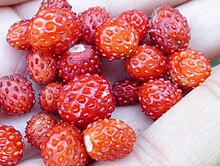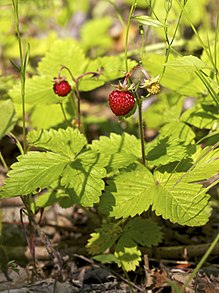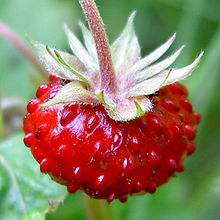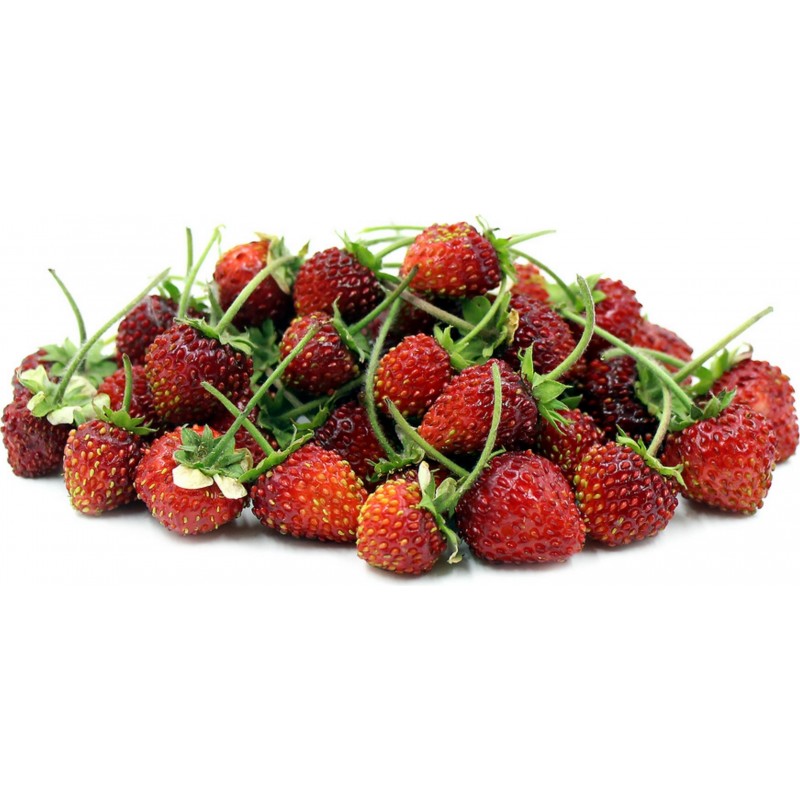
Wild Strawberry Seeds RUGIA (Fragaria vesca)
Wild Strawberry Seeds ‘’RUGIA’’ (Fragaria vesca)
Price for Package of 20 seeds.
Fragaria vesca, commonly called wild strawberry, woodland strawberry, Alpine strawberry, Carpathian Strawberry, European strawberry, or fraisier des bois, is a perennial herbaceous plant
Wild Strawberry Seeds ‘’RUGIA’’ (Fragaria vesca) Fruiting From Spring Until The Frosts
Price for Package of 20 seeds.
Remontant variety (without moustache), very productive whole season – from late spring until frosts. Berries are bright red, medium size, very fragarant and tasty. Variety suitable for use as fresh or for industrial use.
WIKIPEDIA:
Fragaria vesca, commonly called wild strawberry, woodland strawberry, Alpine strawberry, Carpathian Strawberry, European strawberry, or fraisier des bois, is a perennial herbaceous plant in the Rose family that grows naturally throughout much of the Northern Hemisphere, and that produces edible fruits.
Description
Five to eleven soft, hairy white flowers are borne on a green, soft-hairy 3–15 centimetres (1.2–5.9 in) stalk that usually lifts them above the leaves. The light-green leaves are trifoliate (in threes) with toothed margins. The plant spreads by means of runners (stolons).
Taxonomy
Vilmorin-Andrieux (1885) makes a distinction between wild or wood strawberries (Fragaria vesca) and alpine strawberries (Fragaria alpina), a distinction which is not made by most seed companies or nurseries, which usually sell Fragaria vesca as "alpine strawberry".
Under wild or wood strawberry, Vilmorin says:
It has seldom been seen in gardens since the introduction of the Red Alpine Strawberry. ... Wood Strawberry possesses a quite particular perfume and delicacy of flavour. 2,500 seeds to the gramme.
Under alpine strawberry, Vilmorin says:
A very different plant to the Wood Strawberry, and distinguished by the greater size of all its parts — the fruit in particular — and especially by the property (which is particular to it) of producing flowers and fruit continuously all through the summer. ... The fruit has nearly the same appearance and flavour as that of the Wood Strawberry, but is generally larger, longer, and more pointed in shape. The seed is also perceptibly larger and longer. A gramme contains only about 1,500 seeds.
Subspecies
Ecology Fragaria vesca ssp. americana (Porter) Staudt- Fragaria vesca ssp. bracteata (Heller) Staudt
- Fragaria vesca ssp. vesca L.
- Fragaria vesca ssp. semperflorens L.



Typical habitat is along trails and roadsides, embankments, hillsides, stone- and gravel-laid paths and roads, meadows, young woodlands, sparse forest, woodland edges, and clearings. Often plants can be found where they do not get sufficient light to form fruit. In the southern part of its range, it can only grow in shady areas; further north it tolerates more sun.[7] It is tolerant of a variety of moisture levels (except very wet or dry conditions).[7] It can survive mild fires and/or establish itself after fires.[7]
Although F. vesca primarily propagates via runners, viable seeds are also found in soil seed banks and seem to germinate when the soil is disturbed (away from existing populations of F. vesca).[7]
Its leaves serve as significant food source for a variety of ungulates, such as mule deer and elk, and the fruit are eaten by a variety of mammals and birds that also help to distribute the seeds in their droppings.[7]
Genomics
| NCBI genome ID | 3314 |
|---|---|
| Ploidy | diploid |
| Number of chromosomes | 14 |
| Year of completion | 2010 |
The alpine strawberry is used as an indicator plant for diseases that affect the garden strawberry. It is also used as a genetic model plant for garden strawberry and the family Rosaceae in general, due to its:
- very small genome size
- short reproductive cycle (14–15 weeks in climate-controlled greenhouses)
- ease of propagation.
The genome of Fragaria vesca was sequenced in 2010.[8]
All strawberry (Fragaria) species have a base haploid count of seven chromosomes; Fragaria vesca is diploid, having two pairs of these chromosomes for a total of 14.



History, cultivation and uses
Evidence from archaeological excavations suggests that Fragaria vesca has been consumed by humans since the Stone Age.[9]
Woodland strawberry fruit is strongly flavored, and is still collected and grown for domestic use and on a small scale commercially for the use of gourmets and as an ingredient for commercial jam, sauces, liqueurs, cosmetics and alternative medicine.
In Turkey, hundreds of tons of wild fruit are harvested annually, mainly for export.[10] The Ottoman strawberry (also known as the Arnavutköy variety)[11] was once cultivated in large quantities in the Arnavutköy neighbourhood of Istanbul. It is also grown extensively near the town of Karadeniz Ereğli in Zonguldak province, Turkey. A festival to celebrate the Ottoman strawberry is held at Karadeniz Ereğli in June each year.[12]
Most of the cultivated varieties have a long flowering period (and have been considered by botanists as belonging to Fragaria vesca var. vesca ssp. semperflorens). They are usually called alpine strawberries. They either form runners or multiple crowns in a cluster, fruit over a very long period with larger fruit than the common wood strawberry, and are usually propagated by seeds or division of the plants. The type in cultivation is usually everbearing and produces few runners. Plants tend to lose vigour after a few years due to their abundant fruiting and flowering with final decline caused by viral diseases.[13] Large-fruiting forms are known since the 18th century and were called "Fressant" in France.[14] Some cultivars have fruit that are white or yellow when fully ripe, instead of the normal red.
Cultivars that form stolons are often used as groundcover, while cultivars that do not may be used as border plants. Some cultivars are bred for their ornamental value. Hybrids, Fragaria × vescana, have been created from crosses between woodland strawberry and garden strawberry. Hybrids between the woodland strawberry and the European species Fragaria viridis were in cultivation until around 1850, but are now lost.[15]
Alpine strawberry has an undeserved reputation among home gardeners as hard to grow from seed, often with rumors of long and sporadic germination times, cold pre-chilling requirements, etc.[citation needed] In reality, with proper handling of the very small seeds (which can easily be washed away with rough watering), 80% germination rates at 70 °F within 1–2 weeks are easily achievable.
Alpine strawberries are sometimes included as edging plants in herbaceous borders.
Garden varieties currently in cultivation
- Seed-propagated
- Rügen, the first modern cultivar, i.e., runnerless, everbearing and large fruited — originating from Castle Putbus in Germany, first offered 1920 by the strawberry grower Emil Spangenberg from Morsleben.
- Alexandria, first offered 1964 by George W. Park Seed Co., USA
- Baron Solemacher, first offered 1935 by F. C. Heinemann, Germany
- Weisse Solemacher (white fruited) first offered by F. C. Heinemann
- Golden Alexandria (golden foliage).
- Cultivars
Forms with runners are still found in old gardens.
- Quarantaine de Prin, France; commercially important before World War I, but now almost extinct; maybe identical to the variety Erigée de Poitou which was still offered around 1960.
- Blanc Amélioré, Great Britain; white-fruited; it is doubtful if the clone in circulation today is identical to the historical variety from around 1900 because of its non-everbearing habit; nevertheless a good variety with rather large, sometimes monstruous fruit of the Fressant type.
- Illa Martin, Germany; sold as an ornamental, white-fruited. Red achenes have been reported but have not been found. Most plants in circulation not true to name.
- Gartenfreude, Germany; large-fruited form, sometimes very large monstrous fruit of the Fressant type.
Curious mutations have arisen and are sometimes grown by plantsmen and other connoisseurs of the unusual:
- Monophylla (“Strawberry of Versailles”; has one large leaflet instead of the normal three leaflets)[20] - Vilmorin-Andrieux (1885) stated as being raised by Duchesne.
- Multiplex (double flowered; sets less and smaller fruit)
- Muricata (“Plymouth strawberry”; the flowers are composed of numerous small, leafy bracts; the fruit are similarly spiky).
| Sowing Instructions | |
| Propagation: | |
| Pretreat: | 0 |
| Stratification: | 30-60 days |
| Sowing Time: | all year round |
| Sowing Depth: | Needs Light to germinate! Just sprinkle on the surface of the substrate + gently press |
| Sowing Mix: | Coir or sowing mix + sand or perlite |
| Germination temperature: | 20-25°C |
| Location: | bright + keep constantly moist not wet |
| Germination Time: | 1 - 8 weeks |
| Watering: | Water regularly during the growing season |
| Copyright © 2012 Seeds Gallery All Rights Reserved. | |
Sowing: Outdoors in spring or in autumn (could be sown all the season). The seeds is recommended to hold in -5˚C/23˚F temperature (in refrigerator) for 2 months before sowing.
Seedlings is ready to transplant about 30 – 30 days after sowing. The space must be left between plants – 90 x 40 cm/35.4 x 17.7 inch.
| HEIRLOOM ? | Yes |
|---|---|
| Organic Seeds ? | Organic Seeds |
| Edible ? | Edible |
| Pretreatment of sowing ? | Stratification needed: Yes |
| Perennial ? | Perennial plant : Yes |
| Semințe culese manual? | Semințe culese manual |
| Resistant to cold and frost ? | Resistant to cold and frost : - 50° C |
| Seeds requires light for germination ? | Requires light for germination |


Aprecierea ta pentru recenzie nu a putut fi trimisa
Reclama un comentariu
Raport trimis
Reclamatia tau nu a putut fi trimisa
Scrie-ti recenzia
Recenzia a fost trimisa
Recenzia ta nu a putut fi trimisa
🌍 Livrare Globală din UE
Expediem comenzi la nivel mondial din Uniunea Europeană prin poștă înregistrată cu confirmare de primire.
📦 Urmărirea coletului
Pentru a urmări coletul, autentifică-te în contul tău și accesează secțiunea Istoricul comenzilor > Detalii. Acolo vei găsi numărul de urmărire.
Urmărire internațională: 17Track
Pentru numere de tip RGxxxxxxHR: Posta.hr Tracking
🕒 Notă: Informațiile de urmărire devin disponibile după cel puțin 24 de ore de la expediere.
⚠️ Informații importante
Plata ramburs nu este disponibilă.
Verifică dosarul SPAM / Junk al e-mailului pentru a nu rata notificările.
Contactează-ne doar prin formularul de contact de pe site.
E-mailurile directe nu vor fi procesate.
📱 Număr de telefon obligatoriu
La plasarea comenzii, te rugăm să introduci numărul tău de telefon mobil cu prefixul internațional al țării.
Exemplu: +40 712 345 678
🚚 Condiții de livrare
Pentru coletele înregistrate, este necesară semnătura destinatarului.
Nu comanda dacă:
dorești ca pachetul să fie livrat într-o cutie poștală
nu vei fi acasă pentru a-l prelua
dorești ca pachetul să fie lăsat la un vecin (❌ acest lucru nu este posibil)
📬 Dacă oferi o adresă de tip cutie poștală și coletul se pierde, nu ai dreptul la ramburs.
↩️ Returnarea coletului și reexpediere
Dacă, din orice motiv, coletul este returnat către noi:
Vei fi responsabil pentru costul de retur de 2 €
Și pentru costul reexpedierii
⏱ Întârzieri și urmărire
Dacă urmărirea indică „la expeditor”, înseamnă că este în tranzit.
Contactează oficiul poștal local cu numărul de urmărire pentru informații actualizate.
Nu suntem serviciu poștal – nu putem urmări coletul în numele tău.
Nu ne asumăm responsabilitatea pentru timpii de livrare.
🔍 Putem începe o investigație doar după 30 de zile de la data expedierii.
✈️ Opțiuni de livrare
| Tip livrare | Timp procesare | Asigurare | Posibile întârzieri | Detalii |
|---|---|---|---|---|
| Standard | 7–10 zile lucrătoare | ❌ | 7–14 zile | Cea mai ieftină opțiune |
| Prioritară | 1–7 zile lucrătoare | ❌ | 3–10 zile | Comanda procesată prioritar, dar nu livrată mai rapid |
| Asigurată | 1–7 zile lucrătoare | ✅ | 3–10 zile | Rambursare garantată dacă coletul se pierde (până la 150 €) |
🕒 Timp estimativ de livrare:
În UE: 3–20 zile lucrătoare
Internațional: 5–30 zile lucrătoare
Exemple livrări SUA: 27, 22, 19, 17, 13 zile
💳 Metode de plată
💶 Transfer bancar (SEPA / IBAN / SWIFT-BIC)
În descrierea plății trebuie să menționezi codul comenzii (ex. SGS-19811702).
Dacă nu apare codul, comanda poate întârzia sau fi anulată.
Dacă plata nu este recepționată în 7 zile, comanda va fi anulată automat.
🅿️ PayPal
Acceptăm plăți doar în euro.
Te rugăm să selectezi euro în timpul procesului de plată.
💳 Card bancar
Plata se face pe site-ul nostru: Exotic Seeds Store
Acceptăm: Visa, MasterCard, American Express, Diners Club, Discover, JCB, UnionPay etc.
💡 Clientul suportă toate taxele de tranzacție.
Pentru procesare rapidă, trimite dovada plății.
📅 Observații suplimentare
Nu procesăm comenzi și nu expediem sâmbăta sau duminica.
Verifică întotdeauna anunțurile importante de pe site-ul nostru înainte de a plasa o comandă (ex. sărbători sau condiții speciale).
📫 Important:
Nu trimite mesaje pe adresa noastră de e-mail. Folosește exclusiv formularul de contact disponibil pe site-ul nostru.
Related Products











